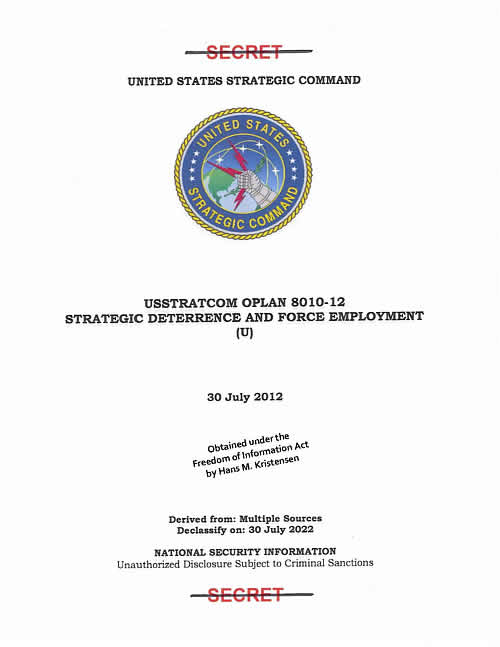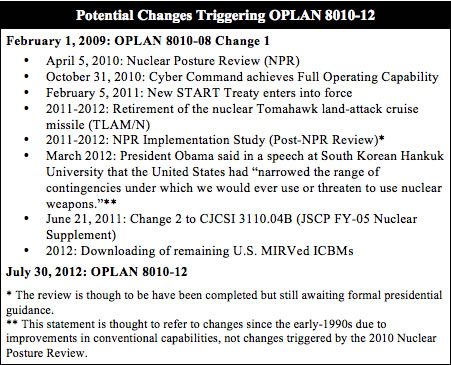
US Nuclear War Plan Updated Amidst Nuclear Policy Review

At the same time the White House is finishing a review of nuclear weapons policy, U.S. Strategic Command has quietly put into effect a new strategic nuclear war plan.
The new plan, which entered into effect in July 2012, is called OPLAN 8010-12 Strategic Deterrence and Force Employment. It replaces an earlier plan from 2008, that was revised in 2009.
A copy of the front page of OPLAN 8010-12 was obtained from U.S. Strategic Command (STRATCOM) under the Freedom of Information Act.
OPLAN 8010-12 is the first strategic nuclear war plan update made since the Obama administration’s Nuclear Posture Review in 2010. The administration has completed another review of nuclear targeting policy but not yet issued new presidential guidance, so the new war plan probably does not incorporate changes resulting from the review.
Triggering Plan Changes
Details of OPLAN 8010-12 are highly classified and it is yet unclear why a new plan has been issued at this point instead of awaiting the results of the administration’s targeting review. Minor adjustments are made to war plans all the time but new plan numbers are thought to reflect more significant changes.
Plan updates can be triggered by several factors: changes in the adversaries that are targeted by the plan; changes to the U.S. nuclear force structure (introduction, modification, or retirement of nuclear weapon systems); or promulgation of new military or political guidance. Since the previous plan change in 2009, several important developments have occurred that could potentially have triggered production of OPLAN 8010-12 (see table).

The formal reason for the new plan was probably the update of the Nuclear Supplement to the Joint Strategic Capabilities Plan (CJCSI 3110.04B) that was issued by the Chairman of the Joint Chiefs of Staff in June 2011. The document, known as JSCP-N (formerly Annex C), provides nuclear planning guidance to combatant commanders in accordance with the Policy Guidance for the Employment of Nuclear Weapons (NUWEP) issued by the Secretary of Defense. This probably eliminates strike scenarios involving the recently retired nuclear Tomahawk land-attack cruise missile (TLAM/N).
Over the same time period, the number of Russian ICBMs declined by approximately 80 missiles, most of them silo-based SS-18 and SS-19 missiles, a change that potentially would allow a reduction of at least 160 warheads from the U.S. war plan.
Plan Context
OPLAN 8010-12 is the nuclear combat employment portion (known as SIOP during the Cold War) of a wider plan also known as OPLAN 8010 (but without the update year). OPLAN 8010 is a “base plan” with annexes, one of which is OPLAN 8010-12. The annexes consist of plans for different elements of national power that span the entire spetrum of STRATCOM missions: nuclear forces; conventional strike options; non-kinetic (incuding cyber operaitons); misssile defense; intelligence, surveillance and reconnaisance; and counter-WMD.
The base plan (OPLAN 8010) is thought to be directed against six potential adversaries: Russia, China, North Korea, Iran, Syria, and WMD attacks by non-state actors.
OPLAN 8010-12 replaces the previous nuclear war plan from 2008 (OPLAN 8010-08), which was most recently updated in February 2009. The current plan is the 18th major plan update since the end of the Cold War (see table).

OPLAN 8010-12 is produced, maintained, and – if so ordered by the president – executed by the Joint Functional Component Command for Global Strike (JFCC-GS), a 430-people unit located at STRATCOM at Offutt Air Force Base in Nebraska. JFCC-GS is responsible for not only nuclear plans but for the full spectrum of kinetic (nuclear and conventional) and non-kinetic effects.
The Name Game
The new plan has a new name: Strategic Deterrence and Force Employment. The previous plan from 2009 was called Strategic Deterrence and Global Strike, changed from the original Global Deterrence and Strike in 2008.
- OPLAN 8010-08 Revision (December 1, 2008): Global Deterrence and Strike
- OPLAN 8010-08 Change 1 (February 1, 2009): Strategic Deterrence and Global Strike
- OPLAN 8010-12 (July 30, 2012): Strategic Deterrence and Force Employment
Three names in five years indicate a plan in evolution. The frequent name changes probably reflect an ongoing search for a name that more accurately captures the essense of the plan. Global Strike might have caused confusion with the non-nuclear Prompt Global Strike mission.
Guiding Further Reductions
As mentioned above, the Obama administration has completed an internal review of U.S. nuclear targeting policy, but has yet to issue formal presidential guidance to the military for how this will affect future revisions of OPLAN 8010-12. Yet indications are that important changes might be forthcoming.
While defense hawks lament the administration’s intension to reduce U.S. (and Russian) nuclear forces, the military has already concluded that nuclear forces can be reduced without undermining national or extended deterrence commitments:
- The Pentagon’s February 2010 Quadrennial Defense Review concluded that “new, tailored, regional deterrence architectures…make possible a reduced role for nuclear weapons in our national security strategy.”
- The Pentagon’s February 2010 Ballistic Missile Defense Review stated: “Against nuclear-armed states, regional deterrence will necessarily include a nuclear component (whether forward-deployed or not). But the role of U.S. nuclear weapons in these regional deterrence architectures can be reduced by increasing the role of missile defenses and other capabilities.”
- The Pentagon’s April 2010 Nuclear Posture Review Report concluded that the United States can deter potential adversaries and reassure allies and partners “at significantly lower nuclear force levels and with reduced reliance on nuclear weapons” while “working to reduce the salience of nuclear weapons in international affairs and moving step-by-step toward eliminating them…”
- The Pentagon’s January 2012 strategy Sustaining U.S. Global Leadership: Priorities for 21st Century Defense concluded that, “It is possible that out deterrence goals can be achieved with a smaller nuclear force, which would reduce the number of nuclear weapons in our inventory as well as their role in U.S. national security strategy.” (Emphasis in original).
Underpinning these decisions is that only small nuclear forces are needed for contingencies against regional adversaries such as North Korea and Iran, which can better be addressed with conventional forces. But even against Russia (and increasingly China), which continues to dominate U.S. nuclear planning, the Pentagon and the Intelligence Community have concluded that “a disarming first strike [against the United States] will most likely not occurr,” and that Russia would “not be able to achieve a militarily significant advantage by any plausible expansion of its strategic nuclear forces, even in a cheating or break-out scenario under the New START Treaty…”
These changes have allowed reductions of nuclear forces and strike scenarios in the past, leaving a stockpile of roughly 4,650 warheads. But although very different from the SIOP, OPLAN 8010-12 is still thought to be focused on nuclear warfighting scenarios using a Cold War-like Triad of nuclear forces on high alert to hold at risk and, if necessary, hunt down and destroy nuclear (and to a smaller extent chemical and biological) forces, command and control facilities, military and national leadership, and war supporting infrastructure in a myriad of tailored strike scenarios.
In Prague four years ago, President Obama said: “To put an end to Cold War thinking, we will reduce the role of nuclear weapons in our national security…” Doing so takes more than trimming limited scenarios against small regional adversaries but changing the core mission against Russia and China.
So when President Obama signs his new Presidential Policy Directive in the near future, it is important that it directs the military to change OPLAN 8010-12 in such a way that it actually puts an end to Cold War thinking. This will be his last chance to do so.
Other background: Reviewing Nuclear Guidance: Putting Obama’s Words Into Action (Arms Control Today, 2011) | Obama and the Nuclear War Pan (FAS 2010) | From Counterforce to Minimal Deterrence (FAS/NRDC 2009)
This publication was made possible by a grant from the Ploughshares Fund. The statements made and views expressed are solely the responsibility of the author.
A military depot in central Belarus has recently been upgraded with additional security perimeters and an access point that indicate it could be intended for housing Russian nuclear warheads for Belarus’ Russia-supplied Iskander missile launchers.
The Indian government announced yesterday that it had conducted the first flight test of its Agni-5 ballistic missile “with Multiple Independently Targetable Re-Entry Vehicle (MIRV) technology.
While many are rightly concerned about Russia’s development of new nuclear-capable systems, fears of substantial nuclear increase may be overblown.
Despite modernization of Russian nuclear forces and warnings about an increase of especially shorter-range non-strategic warheads, we do not yet see such an increase as far as open sources indicate.